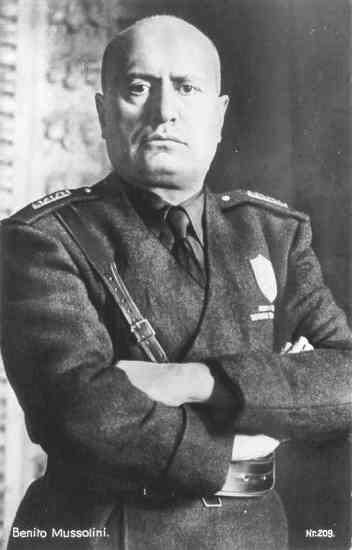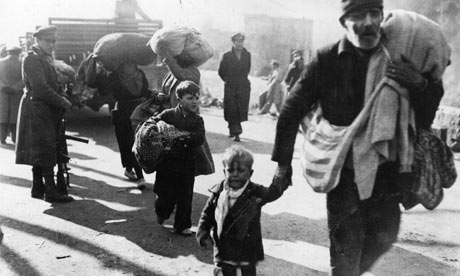I) Roosevelt turns to internationalism – the growing international crisis during the latter 1930s gained more and more of Roosevelt’s attention as his New Deal policies began stalling; Roosevelt’s background left him well-prepared to handle this problem, as well.
A) Threat of Fascism – the world-wide economic crisis of the 1930s led many countries to experiment with new forms of government; one of the most popular was what we call fascism
1) Definition of fascism – government control of all aspects of life, promising a “third way” between Marxism and capitalism, emphasizing the organic national community; it glorified war and violence; it embraced the irrational (like the occult), and the presumption of revolutionary change.
B) Italy
(a) Fascism – rigid, one-party rule which crushes opposition (especially on the left), retention of private ownership of means of production (which differentiates it from the tenets of Marxism), but which operates under centralized government control; belligerent nationalism (and sometimes racism); and the glorification of war.
(b) Il Duce (the leader) – former socialist; appealed to Italian nationalism, and played upon the perceived slights to Italy from its participation on the First World War.
(c) Invasion of Ethiopia – the last independent state on the continent of Africa in the 1930s, but it received no help from other countries to fight of Italian aggression.
C) Germany
1) National Socialism (Nazi)
(a) Hostile to all forms of democracy
(b) Rise of Adolph Hitler
(ii) Racism – believed in the “natural” superiority of the “Aryan” race (whatever that is); racism was a much more important ideology for German fascists than it was for Italians.
(iii) Compare Nazi ideas of the superiority of Aryans to the belief (backed by scientific “proof”) that Anglo-Saxons were destined by biology to rule the earth.
(c) Burning of the Reichstag – fire of suspicious origin (which has been probably rightly been blamed on the Nazis) destroyed the meeting place for the equivalent of the German congress, which then did not meet any longer.
(d) Kristallnach (November 9-10, 1938) – Nazis burned over 200 synagogues, and looted thousands of Jewish-owned stores
(i) Signaled the beginning of a more aggressive anti-Semitism on the part of the German government
(ii) Point of comparison – until Kristallnach, Jews in Germany suffered less discrimination in that country than they suffered in the United States (no restrictions on residence, or clubs they could not join).
(e) Repudiation of the Versailles Treaty – moved arms into the de-militarized Ruhr Valley, also began claiming the right to “lebensraum” or living space, pieces of land that Hitler thought other European powers would not go to war to prevent him from claiming.
D) Japan
1) Greater East Asia Co-Prosperity Sphere – to ensure Japan’s continued access to raw materials to run their industries, forced on other East Asian countries by the military power of Japan.
(a) Invasion of Manchuria – Manchuria lies between China and Russian Siberia, and had traditionally been part of China; had the richest deposit of minerals in Asia.
(b) 1937 Sino-Japanese War – the “Rape of Nanking” which resulted in 300,000 deaths of Chinese civilians; numerous women were carted off to serve as “pleasure girls” (prostitutes for the Japanese army—a practice which they also practiced in other areas in Asia)
2) Racist stereotyping
(a) Japanese superiority – Japanese thought that the Chinese were an inferior people, who gave them the rights to dominate; in the Japanese view, westerners like the US and British were decadent westerners who would crumble when confronted by the pure Japanese spirit.
(b) US racism – US saw Chinese has helpless peasants, largely incapable of self-government; the Japanese, on the other hand, were the “yellow peril,” devious, and set upon ruining the West by exporting their cheap goods, and not buying enough western goods.
E) Spanish Civil War – the Spanish Civil War served as a surrogate battle between fascist and communist forces, with the fascist forces prevailing.
F) Isolationism – the foreign policies of the US government had long promoted isolationism from foreign entanglements, and this; although this had begun to dissipate, it had not disappeared.
1) US Senate rejected membership in the World Court
II) Neutrality Acts – mandated an arms embargo against both victim and aggressor in armed conflict; stipulated a narrower interpretation of neutrality rights; “cash and carry” trade policy for belligerents that would deprive them of access to US credit, ships, and military goods.
III) Pacific Theater of Operation (PTO)
A) Pearl Harbor – Despite the fact that the US was well on its way toward full wartime mobilization, the Japanese attack was still a surprise to the US forces in Honolulu (discuss evidence that some in the US were aware that an attack on Pearl Harbor was imminent)
1) Initial Japanese successes
(a) Indonesia (Dutch)
(b) Indochina (French; spawned the creation of the Vietminh, who with US backing carried on a guerilla war against Japanese—Vietminh were led by a previously exiled, French-educated Vietnamese who renamed himself Ho Chi Minh)
(c) Hong Kong, Malay, and Burma (Great Britain)
(d) Most of eastern China (China)
(e) Philippines (US)
2) US turns tide
(a) Battle of Coral Sea – depleted navy fleet won its first battle of the PTO
(b) Battle of Midway – US gained control of the Central Pacific
3) 1943 – US, with major assistance from Australia and New Zealand, and from many of the indigenous populations of the various Pacific islands and East Asia continental areas, regains the iniative.
B) Island hopping – the strategy of choosing to battle Japanese fortifications on some islands, while skipping (or “hopping”) over others.
1) Amphibious assault
IV) European Theater of Operation (ETO)
1) “Scorched earth” tactics – much of the eastern front had to be given up by the Red Army in a series of strategic retreats, but the Soviets burned to the ground anything that they could not carry with them, which prevented the German Army from obtaining the material, which caused the supply lines of the Germans to be stretched dangerously thin.
2) Battle of Stalingrad – German Army was encircled, supplies from the West were cut off, and the Germans were starved into submission.
B) Air War – to relieve some pressure on the Soviet Union before the Allies were ready to open a second front in Europe.
1) “Precision bombing” – a misnomer; when attacks on industrial areas increased, Germany decentralized its industry, which led to the Allied bombing of population centers—like Dresden in Vonnegut’s Slaughterhouse Five (much of the same thing was happening in the United States, as the government paid industry to build new factories in previously rural areas)
C) Allied invasion of Europe
1) D-Day at Omaha Beach – (show Private Ryan)
D-Day, as it would have been seen on the homefront in the fall of 1944
A more recent re-creation of D-Day
A more recent re-creation of D-Day
V) The Home Front
A) Centralized planning – 1941 was a banner production year for the auto industry, which was reluctant to abandon civilian production to make war material, and did so only under duress (and the promise of guaranteed profits of cost-plus contracts).
B) “Dollar-a-year-men” – executives from the US firms who came to Washington to help the military plan the economy
1) War Production Board – set prices and determined production
2) Suspension of anti-trust laws – encouraged the formation of larger firms, which officials in the military believed would better meet their production criteria—and which made procurement easier.
3) Construction of new factories – at the governments expense, or with low cost government loans (often, after the war, these factories that the government owned were sold to private industry for pennies on the dollar
4) Cost-plus contracts
C) War Labor Board – arbitrated labor-management disputes; set wage rates for all workers. In return, labor officials promised to abide by a “no-strike” pledge, which individual workers supported, except when it involved their own grievances at work.
D) Office of Price Administration – set price ceilings for almost all consumer goods.
E) Selective Service – FDR administration followed the practice of Woodrow Wilson, and instituted a wide-ranging conscription program.
F) War Manpower Commission – determined which workers work was vital to the war effort (which would prevent them from being drafted); also determined when a workers could change jobs.
G) Concentration of the Economy
1) Procurement system – fostered further concentration of the US economy; by the end of the war the top 100 companies held 70% of all civilian and military contracts, compared with 30% five years before.
2) Industrial boom
(a) By 1943 unemployment disappeared
(b) Second Great Migration – whites and blacks leave the South for the Midwest and the West Coast, where most of the jobs created by this economic boom are to be found.
3) Real income growth – 27% between 1939 to 1945
(a) Redistribution of wealth – income of those at the bottom of the wage scale grew at a faster rate than the heavily taxed incomes at the top of the scale.
4) Americanization push – although there were ugly, racist aspects of this new push toward Americanization, it was not anti-European immigrant; in fact, most propaganda celebrated the ethnic diversity of America.
H) Rosie the Riveter – women began to move into industrial jobs in unprecedented numbers during the war years; although most were force to give up those positions at the end of the war, they fought hard to remain in those positions, and a significant number of women remained in the industrial workforce after the war.
1) Male resistance – women who moved into these jobs faced tremendous amounts of resistance from the males who remained on these jobs (give examples of harassment)
2) Working mothers – faced problems relating to the lack of childcare, and the related problem of the alleged juvenile delinquency that their neglect caused.
3) Role of women in society – remained largely unchanged; many saw women in these kinds of positions as a temporary war expediency.
VI) Conclusion – the pressure of "war-time necessity" caused many of the programs to be implemented that the FDR administration had attempted to implement during the two phases of the New Deal; this is transformed in the period after the war to the "military-industrial-government complex" that a later president (Dwight D. Eisenhower, Allied Supreme Commander during the war) warned against in his farewell address in 1959.









No comments:
Post a Comment